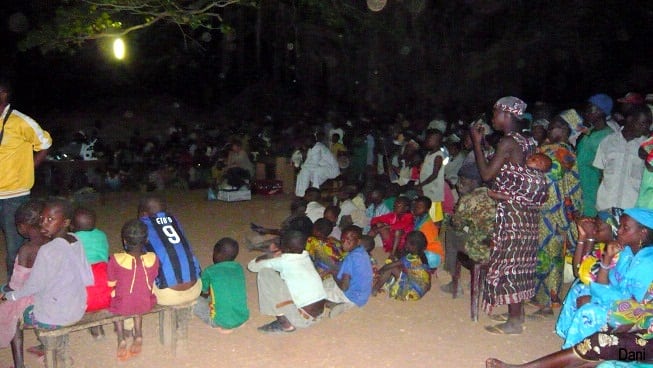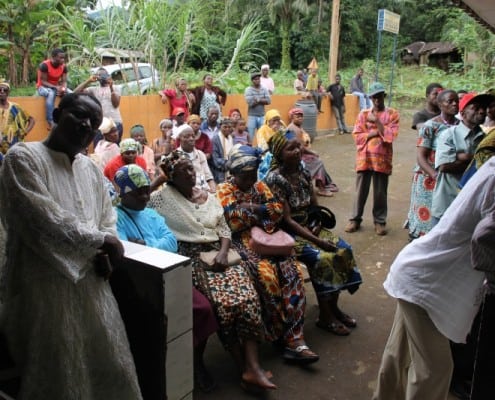Medical Entomology and Parasitology
Courses at the Tübingen University
– Vektorbiologie & Epidemiologie (Sommersemester)
– Organismische Parasitologie (Wintersemester)
=> Beispiele für ein Kursthema: ‘Das Auge und die Flußblindheit, Onchozerkose‘
 Die Studentenprotokolle der letzten Jahre belegen eindrucksvoll das Interesse und die große Begeisterung der Studenten für diese Kombination von Histologie und Parasitologie: 2007-Protokoll-11-Auge-Ionescus-Hegewald; 2008-Protokoll-11-Auge-Daniela-Renz-WS-08-09; 2010-Protokoll-Auge-Flussblindheit-Melanie-Mueller; 2011-12 – Alicja-Sarnecka-Auge-Onchozerkose. Als ganz besonders überzeugend hat sich der praktische Versuch erwiesen, einen Objektträger mit fixierten Mikrofilarien des Erregers Onchocerca volvulus auf den histologischen Schnitt des Auges zu legen: Die Größe der in die Cornea einwandernden Mikrofilarien – ca. 1/4 mm – im Vergleich zu den filigranen Epithelien des Auges. Wird z.B. die einschichtige Descement-Membran an der Innenseite der Cornea verletzt, so kommt es zu lokalen Eintrübungen.
Die Studentenprotokolle der letzten Jahre belegen eindrucksvoll das Interesse und die große Begeisterung der Studenten für diese Kombination von Histologie und Parasitologie: 2007-Protokoll-11-Auge-Ionescus-Hegewald; 2008-Protokoll-11-Auge-Daniela-Renz-WS-08-09; 2010-Protokoll-Auge-Flussblindheit-Melanie-Mueller; 2011-12 – Alicja-Sarnecka-Auge-Onchozerkose. Als ganz besonders überzeugend hat sich der praktische Versuch erwiesen, einen Objektträger mit fixierten Mikrofilarien des Erregers Onchocerca volvulus auf den histologischen Schnitt des Auges zu legen: Die Größe der in die Cornea einwandernden Mikrofilarien – ca. 1/4 mm – im Vergleich zu den filigranen Epithelien des Auges. Wird z.B. die einschichtige Descement-Membran an der Innenseite der Cornea verletzt, so kommt es zu lokalen Eintrübungen.
– Module Parasitologie I & II (Tropenmedizin SS&WS, siehe Campus-Uni-Tübingen)
– Kamerun-Exkursion 2012 (Seminar)
– Vektorbiologische Exkursionen in den Schönbuch und zum K’furter Baggersee (SS)
– Kamerun-Exkursion 2014 => Photos => Report => Seminar => Oncho-presentation in the village
Fundus Tübinger Wissenschaftsgeschichte
- 150 Jahre Mathematisch /-Naturwissenschaftliche Fakultät in Tübingen / Posters
- 100 Jahre Mathematisch /-Naturwissenschaftliche Fakultät in Tübingen
- Seminar Wissenschaftgeschichte
- Fakultätsgründung 1863
- Geschichte-der-Zoologie-WS-2019-Alfons-Renz Presentation on December,12th, 2019, in the seminar of the Department of Developmental Biology
Teaching in Cameroon
Courses at the University in Ngaoundéré
How to present your ideas and results by Powerpoint – Seminar held at Wakwa in August 2014 => PDF
- workshop
- “How to present by Powerpoint” – workshop at IRAD Wakwa
- workshop
Medical Entomology workshop in February – March 2012 => Medical-Entomology-Workshop-Nge-2012
A one-week workshop was held at the Faculty of Natural Sciences at the University of Ngaoundéré, including an excursion with 35 Cameroonian and 9 German students to the National Park of the Benoué.
Practicals were given in – Prospection of Simulium-breeding sites (David Ekale). Read more => Exkursionsbericht – Simulium-breeding-sites-David-Ekale
– Trials of repellents (Icaridin (Doctan), DEET) against blackflies attracted to men and cattle (Stefanie Maier, Daniela Renz). Read more: => Feldversuche mit Doctan in Kamerun-Maier-Renz-2012
– Recognition of recombinantly expressed Onchocerca-antigens by sera of patent cattle (ELISA, Kingsley Manchang). Read more => Exkursionsbericht-ELISA- workshop report-Kingsley-Manchang
– Identification of infective Onchocerca-larvae found in man-biting Simulium flies by PCR (Albert Eisenbarth). Read more => PCR workshop – Albert Eisenbarth
– Prospection of Anopheles, Culex, Aedes and mollusc breeding sites (Lac Dang, Alfons Renz). Read more => Breeding-sites-in-stagnant-water-Renz-2012
Community Outreach in Cameroon
Onchocerciasis-Presentations in the Villages
Teaching in the villages is of paramount importance for onchocerciasis control: To motivate community-directed Ivermectin-masstreatments (APOC), to avoid being bitten by the Simulium vector flies and to wear appropriate protective clothing.
Teaching is much like vaccination: The information (“danger signal”) has to be learned actively by every single person, and is stored either by neurons of the central nerve system or by memory cells of the immune system. The information has to be transformed into action whenever needed: Simulium bites can be actively avoided by clothing and behaviour and microbiotic agents can be eliminated by antibodies or immune-cells. In both cases, infomation is stored for for longtime, but must be boostered from time to time. And both the appropriate behaviour and immunity are not always fully protective. nor is the protective effect quickly visible. This makes both approaches so difficult.
When onchocerciasis-researchers first came into this onchocerciasis-endemic area, there was no treatment available and no larvicide-treatments possible to fight the vectors. The villagers agreed to participate in the medical examinations done by Drs Duke, Anderson and Fuglsang (1974-1977) and by the teams of OCEAC/Centre Pasteur in 1987-2000).
It was in 1987, when we designed the first large-scale field-trial of ivermectin-mastreatment in the villages along the river Vina du Nord. This was the first time, that the villagers benefited from a new drug, that effectively killed the worm larvae (microfilariae) in the skin. Both research and ivermectin mass-treatment largely depends from the good-will and participation of the village populations. This is why information is so important. It was through these oncho-campaigns that the villagers first learned that blindness is not a scourge on the land, but the devastating effect of a minute worm, that they could see under the microscope. And that the adults worms can even be palpated in the subcutaneous nodules. We did such village presentations with the help of a generator and a slide-projector in 1985 and with a video-beamer in 2011. For the villagers, some of even well remembered our visits 20 or 30 years ago, this was a convincing sign, that their participation in research was not en vain.
Onchocerciasis-presentation in the village Karna-Manga, March 2011:

Karna Manga is located near the Benoué river in the Sudan savanna north of Ngaoundéré. It was one of the study villages in 1989-1993, where the epidemiology and cross-transmission of human and bovine onchocerciasis was examined (Wahl et al. 1997)
Oncho-presentations in villages along the river Vina in 1985 (photos Soramboum)









